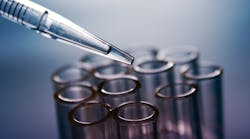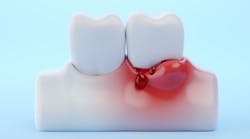Antimicrobial resistance and its effects on the periodontal environment
A recent class action lawsuit filed in September (Vasseur v. Johnson & Johnson Consumer, Inc., No. 2:24-cv-7487 [C.D. Cal. filed 2024]) has the dental community abuzz. The lawsuit alleges that a common mouthwash misleads consumers of its potential for proliferation of harmful bacteria through regular use of the product. Recently, clinicians are beginning to question and try to understand that ingredients in antimicrobials might not get their patients to the disease-free end game they’re looking for. A question that gets asked often is, “How does a mouthwash, while killing pathogens, increase the abundance of oral opportunistic bacteria?”
The first questions to ask are: What’s the purpose of using a mouthwash? Is it intended to prevent oral bacteria from adhering to surfaces, or to eliminate bacteria? Does it target only pathogenic or cariogenic bacteria?
Mouthwashes can have a limited effect on mature biofilms. While they can reduce the overall microbial load and disrupt some components of biofilms, mature biofilms are typically more resistant due to their dense structure and protective extracellular matrix. This matrix impedes the penetration of antimicrobial agents, making it challenging for mouthwashes to fully eradicate biofilms. Over time, incomplete penetration and repeated exposure can lead to the adaptation of the biofilm and potential resistance. The mature oral biofilm’s exposure to mouthwash creates other potential adverse effects, including the emergence of resistant strains, residual structural integrity, increased pathogenicity due to delayed penetration, and ecological shifts within the microbiota.1
The relationship between the host and the biofilm formed by commensal bacteria is antagonistic, symbiotic, and mutualistic. Commensal bacteria contribute to optimal tissue structure and function, as well as protecting the host from exogenous microorganisms by saturating niches. Strategies to control the oral biofilm should involve preserving the benefits of the normal resident microflora. It remains surprising that few mouthwash studies have been performed in vivo, with a lack of systematic reviews and national and international guidelines to advise the public and dental practitioners across the globe on when and how to use mouthwashes.2
Antimicrobial resistance
Antimicrobial treatments, including antibiotics and antiseptics, are commonly used to manage periodontal infections. However, the emergence of antimicrobial resistance (AMR) among periodontal pathogens poses a significant challenge. This resistance is influenced by factors such as nutrient exchange, gene transfer, and interspecies cell signaling, all of which promote bacterial adaptation and survival. Understanding these mechanisms is essential for developing effective, targeted therapies for periodontal disease. The complexity of the oral microbiome, characterized by intricate microbial interactions and host immune responses, coupled with the recent increase in AMR among pathogens, has heightened the need for innovative treatment strategies to combat these resistant strains.
AMR classification
AMR is generally classified into three levels: multidrug resistance (MDR), extensive drug resistance (XDR), and pan-drug resistance (PDR). MDR occurs when a microorganism is resistant to at least one antimicrobial agent from three or more different classes. In cases of XDR, the microorganism is resistant to one or more agents in all but one or two antimicrobial classes. The most severe form, PDR, is marked by resistance to all available antimicrobial agents across every class, leaving very limited treatment options.
Tolerance differs from resistance in how microorganisms respond to antimicrobials. While resistance involves genetic changes that actively counteract the antimicrobial (rendering it ineffective), tolerance allows microorganisms to endure high antimicrobial concentrations by temporarily reducing their metabolic activity. This lowered metabolic state doesn’t destroy the antimicrobial agent, but rather, lets the microorganisms “wait it out.” Because tolerance doesn’t rely on specific genetic resistance mechanisms, these microorganisms aren’t truly resistant; instead, they survive by slowing down processes that the antimicrobial would otherwise target.
Horizontal gene transfer
Antiseptic ingredients such as quaternary ammonium compounds, triclosan, chlorhexidine, and ethanol chlorine-based disinfectants can promote the spread of AMR through mutation or horizontal gene transfer (HGT).3-7 Current increases in disinfection practices may pose an environmental and public health risk by accelerating the spread of AMR.8
It has been demonstrated that the penetration of antimicrobial compounds in biofilms is low, as is that of mouthwashes, especially during short-term exposure. But the retarded penetration of mouthwash can cause the exposure of microorganisms inside the biofilms to subminimum inhibitory concentrations of active ingredients, and this antimicrobial stress may upregulate pathogenic genes and facilitate HGT.
HGT is a primary driver of AMR in periodontal biofilms and can happen in a few ways. Bacteria connect through a bridge and directly transfer DNA-carrying resistant genes from one cell to another. The bacteria can pick up pieces of DNA from their environment, often from dead bacteria, which may include those resistance genes, or viruses that infect bacteria, called bacteriophages. They then can carry resistant genes from one bacterium to another as they move between cells.
In the oral cavity, biofilm communities are densely populated, facilitating close bacterial interactions that promote gene transfer. For instance, plasmids (small, circular pieces of DNA) containing resistance genes can move from one bacterium to another, allowing rapid spread of AMR. This gene transfer is accelerated by the selective pressure inflicted by antimicrobial agents, which favor the survival of resistant strains.
Additionally, periodontal pathogens are known to exchange genes with commensal bacteria, thus creating reservoirs of resistance that can complicate periodontal therapy. Gene transfer mechanisms not only facilitate the acquisition of resistance genes but also contribute to the persistence and adaptation of periodontal pathogens within biofilms. Mutations also play a significant role in AMR by providing survival advantages to bacteria. Point mutations in target sites can make it harder for drugs to inhibit bacterial growth effectively, or bacteria may increase the number of genes responsible for producing efflux pumps. An efflux pump is a protein-based transport mechanism found in the cell membrane of many bacteria (and some other cells) that actively expels toxic substances, including antibiotics, out of the cell. This system helps bacteria survive in hostile environments by reducing the concentration of harmful agents within the cell, contributing to AMR. Efflux pumps can transport a wide variety of substances, making them a major factor in multidrug resistance. Their activity can decrease the effectiveness of antibiotics and hinder treatment outcomes for bacterial infections.
The periodontal environment
In the periodontal environment, nutrient exchange between bacterial species is essential for sustaining biofilm communities. This symbiotic sharing creates a nutrient-rich setting that promotes the growth of diverse microbial species, including antibiotic-resistant strains. Studies show that the complex structure of periodontal biofilms enhances nutrient gradients, where bacteria can share resources such as amino acids, peptides, and vitamins. Porphyromonas gingivalis and Tannerella forsythia rely on amino acids provided by other bacterial species to survive, thus enhancing biofilm persistence and resistance to antimicrobial agents.
The nutrient exchange also impacts antimicrobial efficacy. Antibiotics targeting active bacterial metabolism may be less effective in biofilm communities with inactive bacteria that rely on shared nutrients for survival. Nutrient sharing among species creates metabolic adaptability, making it difficult to eradicate biofilms with standard antimicrobial treatments. Bacteria within periodontal biofilms communicate through cell signaling mechanisms, such as quorum sensing, which regulates gene expression based on population density. This allows bacteria to coordinate activities such as biofilm formation, virulence factor production, and resistance mechanisms.
When exposed to low levels of antimicrobials, bacteria in biofilms—such as those in periodontal pockets—can develop enhanced defenses against stressors, including immune responses and other antimicrobial agents. Sublethal doses of antimicrobials trigger cell signaling pathways that activate stress responses and resistance genes, helping bacteria adapt to hostile environments. These cross-
adaptation mechanisms in periodontal biofilms increase resistance not only to antibiotics but also to antiseptics, disinfectants, and immune defenses, allowing resistant strains to persist and contribute to chronic infections.9
The balance between bacterial activity and the host’s immune response, known as tissue homeostasis, is essential for maintaining periodontal health. Inflammation disrupts this balance, creating an environment conducive to the growth of pathogenic bacteria and promoting AMR. Periodontal pathogens release virulence factors that trigger inflammatory responses, leading to tissue destruction and impaired homeostasis.10 This inflammation-induced tissue breakdown provides nutrients that sustain bacterial growth and resistance.
The use of antimicrobial treatments, including antibiotics, can inadvertently disrupt tissue homeostasis and promote microbial dysbiosis, encouraging the growth of resistant species. The combined effect of disrupted homeostasis and the selective pressure from these agents accelerates the emergence and spread of AMR within periodontal biofilms.
Given the intricate relationships among nutrient exchange, gene transfer, cell signaling, cross-adaptation, and tissue homeostasis, addressing AMR in periodontal disease requires a multifaceted approach. Future therapies should focus on disrupting biofilm architecture, targeting signaling pathways involved in resistance, and restoring microbial homeostasis. Strategies such as probiotics, biofilm-disrupting agents, and phage therapy hold promise in combating AMR in periodontal disease.
Acknowledgement: The author would like to express her gratitude to Lora Hooper, BSDH, RDH, EFDA, for her assistance in this article.
Editor's note: This article appeared in the January/February 2025 print edition of RDH magazine. Dental hygienists in North America are eligible for a complimentary print subscription. Sign up here.
References
- Takenaka S, Sotozono M, Ohkura N, Noiri Y. Evidence on the use of mouthwash for the control of supragingival biofilm and its potential adverse effects. Antibiotics (Basel). 2022;11(6):727. doi:10.3390/antibiotics11060727
- Brookes Z, McGrath C, McCullough M. Antimicrobial mouthwashes: an overview of mechanisms–what do we still need to know? Int Dent J. 2023;73 Suppl 2(Suppl 2):S64-S68. doi:10.1016/j.identj.2023.08.009
- Tandukar M, Oh S, Tezel U, Konstantinidis KT, Pavlostathis SG. Long-term exposure to benzalkonium chloride disinfectants results in change of microbial community structure and increased antimicrobial resistance. Environ Sci Technol. 2013;47(17):9730-9738. doi:10.1021/es401507k
- Lu J, Jin M, Nguyen SH, et al. Non-antibiotic antimicrobial triclosan induces multiple antibiotic resistance through genetic mutation. Environ Int. 2018;118:257-265. doi:10.1016/j.envint.2018.06.004
- Wand ME, Bock LJ, Bonney LC, Sutton JM. Mechanisms of increased resistance to chlorhexidine and cross-resistance to colistin following exposure of Klebsiella pneumoniae clinical isolates to chlorhexidine. Antimicrob Agents Chemother. 2016;61(1):e01162-16. doi:10.1128/AAC.01162-16
- Jin M, Liu L, Wang DN, et al. Chlorine disinfection promotes the exchange of antibiotic resistance genes across bacterial genera by natural transformation. ISME J. 2020;14(7):1847-1856. doi:10.1038/s41396-020-0656-9
- Li D, Zeng S, He M, Gu AZ. Water disinfection byproducts induce antibiotic resistance-role of environmental pollutants in resistance phenomena. Environ Sci Technol. 2016;50(6):3193-3201. doi:10.1021/acs.est.5b05113
- Lu J, Guo J. Disinfection spreads antimicrobial resistance. Science. 2021;371(6528):474. doi:10.1126/science.abg4380
- Ciofu O, Moser C, Jensen PØ, Høiby N. Tolerance and resistance of microbial biofilms. Nat Rev Microbiol. 2022;20(10):621-635. doi:10.1038/s41579-022-00682-4
- Darveau RP. Periodontitis: a polymicrobial disruption of host homeostasis. Nat Rev Microbiol. 2010;8(7):481-490. doi:10.1038/nrmicro2337
About the Author

Anne O. Rice, BS, RDH, CDP, FAAOSH
Anne O. Rice, BS, RDH, CDP, FAAOSH, founded Oral Systemic Seminars after over 35 years of clinical practice and is passionate about educating the community on modifiable risk factors for dementia and their relationship to dentistry. She is a certified dementia practitioner, a longevity specialist, a fellow with AAOSH, and has consulted for Weill Cornell Alzheimer’s Prevention Clinic, FAU, and Atria Institute. Reach out to Anne at anneorice.com.


